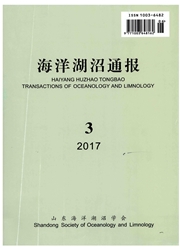

 中文摘要:
中文摘要:
依据2012年1月至2013年12月2年的GOCI(Geostationary Ocean Color Imager)卫星总悬浮体数据,分析了长江口毗邻水域的表层悬浮体锋面(浓度≥2mg/L)的周、月变化特征,并对其机制进行了初步分析。研究结果显示,长江口毗邻水域表层悬浮体锋面变化可基本分为4个阶段,即:1~3月的外输稳定阶段、4~5月的向岸退缩阶段、6~8月的内储稳定阶段、9~12月的向海扩张阶段。4月由输变退,9月由退变输,1月向外海扩散面积最为广阔,6月向岸退缩得最近。春夏交替时期悬浮体锋面的退缩速度较秋冬交替时的扩张速度快约1倍。一年中,退缩最快的时段约在第15~17周,扩张最快的时段约为第38~39周。结果还表明悬浮体锋面的变化速度与风速的变化速度有很大的相关性。
 英文摘要:
英文摘要:
The weekly/monthly variation of surface suspended matter (concentration≥2mg/L) around Yangtze River estuary and adjacent waters was investigated with the GOCI (Geostationary Ocean Color Imager) products from January 2012 to December 2013. The results show that the variations in the dis- tribution of the suspended matter front can be divided into four stages: stable stage from January to March when most areas are covered by water with the concentration higher than 2 mg/L, onshore re- treat stage from April to May as the water bodies with large TSM (total suspended matte) values move back to the coast, stored stage in June-August when the TSM is stored near the coast and expanding stage from September to December when the TSM moves into the open areas. April and September are the transitional periods. The suspended sediments move furthest into the open sea in January while in June they retreat closest to the shore. The rate of suspended matter front variation is faster in spring than in autumn, and the largest variance is from week 15 to 17 and week 38 to 39 in a year. The prelim- inary study suggests that the rate of suspended sediment front variation is closely related to wind speed.
 同期刊论文项目
同期刊论文项目
 同项目期刊论文
同项目期刊论文
 期刊信息
期刊信息
